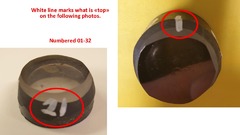Blar i tittel Institutt for geovitenskap
Viser treff 295-314 av 989
-
Gamle olje- og gass-lekkasjer i Barentshavet
(Chronicle; Kronikk, 2010-08-28) -
Garnet growth and mineral geochronology constrains the diachronous Neoproterozoic convergent evolution of the southern Dom Feliciano Belt, Uruguay
(Journal article; Tidsskriftartikkel; Peer reviewed, 2023-05-15)The Dom Feliciano Belt of southern Brazil and Uruguay represents part of a larger Neoproterozoic orogenic system formed during the amalgamation of Western Gondwana. The hinterland and foreland domains in parts of the belt preserve deformation structures and metamorphic assemblages that developed during early crustal thickening from c. 650 Ma. However, the metamorphic history of the southern foreland, ... -
Gas hydrate and free gas detection using seismic quality factor estimates from high-resolution P-cable 3D seismic data
(Journal article; Tidsskriftartikkel; Peer reviewed, 2015-09-23)We have estimated the seismic attenuation in gas hydrate and free-gas-bearing sediments from high-resolution P-cable 3D seismic data from the Vestnesa Ridge on the Arctic continental margin of Svalbard. P-cable data have a broad bandwidth (20–300 Hz), which is extremely advantageous in estimating seismic attenuation in a medium. The seismic quality factor (Q), the inverse of seismic attenuation, ... -
Gas hydrate dissociation off Svalbard induced by isostatic rebound rather than global warming
(Journal article; Tidsskriftartikkel; Peer reviewed, 2018-01-08)Methane seepage from the upper continental slopes of Western Svalbard has previously been attributed to gas hydrate dissociation induced by anthropogenic warming of ambient bottom waters. Here we show that sediment cores drilled off Prins Karls Foreland contain freshwater from dissociating hydrates. However, our modeling indicates that the observed pore water freshening began around 8 ka BP when ... -
Gas hydrate stability zone of the Barents Sea and Kara Sea region
(Journal article; Tidsskriftartikkel; Peer reviewed, 2016-11-29)In this study we assess the present-day gas hydrate stability zone for the Barents Sea and Kara Sea region. Thereby, we make use of a data-based 3D lithosphere-scale pressure and thermal model. The resulting gas hydrate stability zone varies within >1km across the study area and strongly correlates with the local geological settings and the corresponding geothermal gradient. Gas hydrates containing ... -
Gas migration and sealing modelling in the Haapet Dome area, Norwegian Barents Sea - analysis of seismic anomalies and water column data
(Master thesis; Mastergradsoppgave, 2020-05-15)Seismic interpretation, water column data, and well information have enabled a thorough review of shallow amplitude anomalies and subsurface faulting, in conjunction with possible migration pathways in the Haapet Dome area. The processed water column data from the MAREANO-program was presented and evaluated in accordance with potential gas leakage from the seafloor. Water column imaging illustrates ... -
Gas seeps in Norwegian waters – distribution and mechanisms
(Journal article; Tidsskriftartikkel; Peer reviewed, 2023-06-01)Gas seeps and fluid-flow related seabed features are found over the entire Norwegian exclusive economic zone (EEZ). Multibeam water-column data from c. 136 000 km2 has revealed more than 5 000 gas seeps. Most of the gas seeps seem to have biogenic, thermogenic or mixed origin; some may be of abiotic origin. The spatial distribution of the gas seeps appears to correlate with: 1 – structural highs ... -
Gas seeps in the Barents Sea – how does the geology influence the natural and well related seeps?
(Master thesis; Mastergradsoppgave, 2021-07-15)This thesis examined gas flares found in the Cruise log 20-2 from CAGE and correlated them to subsurface seismic data in south of Barents Sea. The cruise log passed several hydrocarbon discoveries/fields such as Goliat, Caurus/Langlitinden, Norvarg and Wisting/Hanssen. The aim of the thesis is to investigate the relationship between shallow geology and the observed gas flares and seabed leakages. ... -
GEO-3144/8144 Teaching Cruise: Geologically controlled hydrocarbon seepage in Hopendjupet and the wider Barents Sea
(Research report; Forskningsrapport, 2022-11-18)The CAGE22-6 cruise on-board R/V Helmer Hanssen hosted UiT´s Arctic Marine Geology and Geophysics (GEO-8144 and GEO-3144) field course for PhD and Master students, and was carried out in collaboration with NPD – the Norwegian Petroleum Directorate and the INTPART project HOTMUD based at Centre for Earth Evolution and Dynamics (CEED) the University of Oslo. The cruise was also a part of the UNESCO ... -
Geochemical characterisation of northern Norwegian fjord surface sediments: A baseline for further paleo-environmental investigations
(Journal article; Tidsskriftartikkel; Peer reviewed, 2017-08-26)Norwegian fjord sediments are promising archives for very high resolution records of past environmental changes. Recent investigations of the modern depositional environment within fjords revealed that the accurate quantification of the inputs, sources, and sedimentary preservation of organic and inorganic material is crucial to decipher long term past climate signals in the sedimentary record ... -
Geochemical characteristics of sediment- and mafic rock-hosted Cu deposits in the Kåfjord area, Alta-Kvænangen Tectonic Window, Northern Norway
(Mastergradsoppgave; Master thesis, 2021-06-15)The Precambrian Alta-Kvænangen Tectonic Window (AKTW) located in the northern part of Norway, hosts different types of copper mineralization. Some of Cu occurrences have been previously mined, but their geochemical and stable isotope characteristics have not been a subject of detailed investigations, and therefore the relevant ore-forming processes are still poorly understood. This study, brings new ... -
Geochemical evidence for seabed fluid flow linked to the subsea permafrost outer border in the South Kara Sea
(Journal article; Tidsskriftartikkel; Peer reviewed, 2019-04-16)Driven by rising bottom water temperatures, the thawing of subsea permafrost leads to an increase in fluid flow intensity in shallow marine sediments and results in the emission of methane into the water column. Limiting the release of permafrost-related gas hydrates and permafrost- sequestered methane into the global carbon cycle are of primary importance to the prevention of future Arctic Ocean ... -
Geochemical investigations of northern Norwegian fjord sediments - Sources and spatial variability of marine and terrigenous components
(Master thesis; Mastergradsoppgave, 2016-05-11)Fjords represent unique coastal marine environments with high sedimentation rates. They can be used for intensive investigations focusing on geochemical, mineralogical, biological, and sedimentological processes. In this study I investigate 42 surface sediment samples from the outer and inner parts of the Vestfjord, Ofotfjord, Tysfjord and tributary fjord arms in northern Norway. Samples were analysed ... -
The geochemical signature of Cu mineralisation preserved in stream sediments from the Alta-Kvænangen Tectonic Window, Northern Norway
(Master thesis; Mastergradsoppgave, 2021-06-13)The Paleoproterozoic Greenstone Belts of Fennoscandia are metamorphosed and deformed volcanic and sedimentary basins with a high metallic ore potential. One of those, the Alta-Kvænangen Tectonic Window (AKTW), is exposed as a window below the Caledonides of Northern Norway. The Kåfjord area located within the AKTW hosts numerous known Cu occurrences. The Cu mineralisation in Kåfjord occurs mostly ... -
Geochemistry of rutile-bearing veins at Engebøfjellet, Naustdal, Norway.
(Master thesis; Mastergradsoppgave, 2018-11-15)The Engebøfjellet eclogite, located in Naustdal, Norway, contain quartz veins with large rutile (TiO2) phenocrystals. Trace element composition of rutile deposited in veins and in the eclogite matrix was analysed with the use of LA-ICP-MS. The Nb content decrease with increasing V in the rutile, and contents of these elements vary depending on depositional environment. One quartz vein associated ... -
Geochemistry of the stratiform iron Dunderlandsdalen deposits, Nordland
(Master thesis; Mastergradsoppgave, 2019-05-15)The Dunderlandsdalen iron district, Northern Norway, hosts a world-class stratiform Fe-mineralization (total tonnage of ~500 Mt at 33% Fe). The iron ore units belong to the Dunderland Formation in the Ramnålia Nappe, which further belongs to the Rødingsfjellet Nappe of the Caledonian Uppermost Allochthon. Hematite and magnetite represent the principal ore minerals and are hosted by amphibolite grade ... -
Geochronology and chemostratigraphy of the 2.47–1.96 Ga rift-related volcano-sedimentary succession in the Karasjok Greenstone Belt, northern Norway, and its regional correlation within the Fennoscandian Shield
(Journal article; Tidsskriftartikkel; Peer reviewed, 2023-09-09)New geochronological data for the amphibolite-facies volcano-sedimentary Karasjok Greenstone Belt in northwestern Fennoscandia bracket its age between 2.47 and 1.96 Ga. The volcano-sedimentary units were deposited on the 3005 24 to 2776 69 Ma crystalline basement rocks of the Jergul Gneiss Complex. The lowermost Vuomegielas Formation contains rhyodacites dated at 2469 12 Ma that were deposited in ... -
Geofaglig kunnskap og holdninger til norsk petroleumsnæring. En casestudie av Alta/Gohta
(Master thesis; Mastergradsoppgave, 2018-05-15)Denne oppgaven har som hovedfokus å belyse holdninger og geofaglig kunnskap knyttet til norsk petroleumsnæring. Oppgaven tar utgangspunkt i olje- og gassfunnene Alta/Gohta i Barentshavet. Et geofaglig litteraturstudie har blitt gjennomført for å oppnå en forståelse av funnenes geologi og særegenheter. Intervjuer med norsk petroleumsnærings hovedaktører; olje- og energidepartementet, oljedirektoratet, ... -
Geologi og klimaendringer
(Conference object; Konferansebidrag, 2010-09-02) -
Geological controlling parameters on seismic imaging of igneous intrusions on Svalbard
(Master thesis; Mastergradsoppgave, 2017-05-15)Imaging and mapping igneous intrusions such a sills and dykes has been one of the challenges in recent years. However, igneous intrusions in seismic data have properties that make them good targets for visualization, such as high amplitude and sophisticated shapes. 3D visualization methods are especially well suited for sill reflections. One of the main limitations of tying offshore seismic data to ...


 English
English norsk
norsk


















